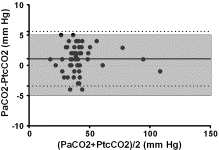Concordance between transcutaneous and arterial measurements of carbon dioxide in an ED☆
Affiliations
- Department of Emergency Medicine and Surgery, Centre Hospitalo-Universitaire Pitié-Salpêtrière, Assistance-Publique Hôpitaux de Paris (AP-HP), 47-83 boulevard de l'hôpital, 75013 Paris, Université Pierre et Marie Curie Paris 6, France
Correspondence
- Corresponding author. Service d'Accueil des Urgences, Groupe Hospitalier Pitié-Salpêtrière, 47-83 boulevard de l'hôpital, 75013 Paris, France. Tel.: +33 1 42 17 72 41; fax: +33 1 42 17 72 64.

Affiliations
- Department of Emergency Medicine and Surgery, Centre Hospitalo-Universitaire Pitié-Salpêtrière, Assistance-Publique Hôpitaux de Paris (AP-HP), 47-83 boulevard de l'hôpital, 75013 Paris, Université Pierre et Marie Curie Paris 6, France
Correspondence
- Corresponding author. Service d'Accueil des Urgences, Groupe Hospitalier Pitié-Salpêtrière, 47-83 boulevard de l'hôpital, 75013 Paris, France. Tel.: +33 1 42 17 72 41; fax: +33 1 42 17 72 64.
Affiliations
- Department of Emergency Medicine and Surgery, Centre Hospitalo-Universitaire Pitié-Salpêtrière, Assistance-Publique Hôpitaux de Paris (AP-HP), 47-83 boulevard de l'hôpital, 75013 Paris, Université Pierre et Marie Curie Paris 6, France
Affiliations
- Department of Emergency Medicine and Surgery, Centre Hospitalo-Universitaire Pitié-Salpêtrière, Assistance-Publique Hôpitaux de Paris (AP-HP), 47-83 boulevard de l'hôpital, 75013 Paris, Université Pierre et Marie Curie Paris 6, France
Affiliations
- Department of Emergency Medicine and Surgery, Centre Hospitalo-Universitaire Pitié-Salpêtrière, Assistance-Publique Hôpitaux de Paris (AP-HP), 47-83 boulevard de l'hôpital, 75013 Paris, Université Pierre et Marie Curie Paris 6, France
Affiliations
- Department of Anesthesiology and Critical Care, Centre Hospitalo-Universitaire Pitié-Salpêtrière, Assistance-Publique Hôpitaux de Paris (AP-HP), 47-83 boulevard de l'hôpital, 75013 Paris, Université Pierre et Marie Curie Paris 6, France
Affiliations
- Department of Emergency Biology, Centre Hospitalo-Universitaire Pitié-Salpêtrière, Assistance-Publique Hôpitaux de Paris (AP-HP), 47-83 boulevard de l'hôpital, 75013 Paris, Université Pierre et Marie Curie Paris 6, France
Affiliations
- Department of Emergency Medicine and Surgery, Centre Hospitalo-Universitaire Pitié-Salpêtrière, Assistance-Publique Hôpitaux de Paris (AP-HP), 47-83 boulevard de l'hôpital, 75013 Paris, Université Pierre et Marie Curie Paris 6, France
Affiliations
- Department of Emergency Medicine and Surgery, Centre Hospitalo-Universitaire Tenon-Saint Antoine, Assistance-Publique Hôpitaux de Paris (AP-HP), 4 rue de la Chine, 75020 Paris, Université Pierre et Marie Curie Paris 6, France
 Article Info
Article Info
To view the full text, please login as a subscribed user or purchase a subscription. Click here to view the full text on ScienceDirect.

Fig. 1
Linear correlation between transcutaneous PtcCO2 and PaCO2. Regression line is the continuous line; 95% CI lines, dotted lines.

Fig. 2
Bland-Altman representation of comparison analysis between PaCO2 and PtcCO2 vs means of paired measurements. The bias is shown as continuous line; limits of agreement (bias ±1.95 SD), dashed lines; and the shaded area, the outlier limits (±5 mm Hg).
Abstract
Background
Transcutaneous carbon dioxide pressure (PtcCO2) has been suggested as a noninvasive surrogate of arterial carbon dioxide pressure (PaCO2). Our study evaluates the reliability of this method in spontaneously breathing patients in an emergency department.
Patients and methods
A prospective, observational study was performed in nonintubated dyspneic patients who required measurement of arterial blood gases. Simultaneously and blindly to the physicians in charge, PtcCO2 was measured using a TOSCA 500 monitor (Radiometer, Villeurbanne, France). Agreement between PaCO2 and PtcCO2 was assessed using the Bland-Altman method.
Results
Forty-eight patients (mean age, 65 years) were included, and 50 measurements were done. Eleven (23%) had acute heart failure; 10 (21%), pneumonia; 7 (15%), acute asthma; and 7 (15%), exacerbation of chronic obstructive pulmonary disease. Median PaCO2 was 42 mm Hg (range, 17-109). Mean difference between PaCO2 and PtcCO2 was 1 mm Hg with 95% limits of agreement of −3.4 to +5.6 mm Hg. All measurement differences were within 5 mm Hg, and 32 (64%) were within 2 mm Hg.
Conclusion
Transcutaneous carbon dioxide pressure accurately predicts PaCO2 in spontaneously breathing patients.
To access this article, please choose from the options below
Purchase access to this article
Claim Access
If you are a current subscriber with Society Membership or an Account Number, claim your access now.
Subscribe to this title
Purchase a subscription to gain access to this and all other articles in this journal.
Institutional Access
Visit ScienceDirect to see if you have access via your institution.
☆Conflicts of interest: The TOSCA 500 monitor, lines, and probes were supplied, free of charge, by Radiometer, Villeurbanne, France.
Related Articles
Searching for related articles..


